First up in a series of about eight AR-15 drop-in trigger reviews are the Elftmann Tactical ELF Match and 3-Gun triggers. I’ve been playing with these since early November and — spoiler alert — I like ’em a lot. That said, I have no way of testing out claims such as “incredibly fast lock time.” Actually, this may be changing as we’re working on borrowing a Dvorak TriggerScan to objectively compare all of these AR triggers back-to-back, so stay tuned. Regardless, the ELF triggers have a couple of features that set them apart from the pack . . .
Want to know what it feels like? The video above, complete with close-up trigger pulls, is your best bet.
Completely unique to Elftmann is the use of roller bearings in the trigger and hammer pivots:
This is supposed to result in smoother and faster operation. Again, I can’t measure whether it’s faster, but the trigger and hammer certainly do move smoothly.
Speaking of faster, “lock time” is the delay between the trigger breaking (the sear releasing the hammer) and the round igniting. A faster lock time generally means better accuracy. The concept becomes crystal clear if you imagine something like a flintlock rifle, where a meaningful delay exists between trigger break and projectile leaving the barrel (slow-mo footage). Even counting in milliseconds, it doesn’t take many of them to give you enough time to screw up a shot by moving the muzzle from “perfect” to “not so much” during the lock time delay.
Elftmann originally said that its 3-Gun trigger has the shortest AR-15 trigger lock time on the planet, but they’ve scaled it back to “incredibly fast lock time” until they can scientifically prove just how fast it is. They are quite confident, however, based on the fact that it has a particularly lightweight, skeletonized hammer, a full-power hammer spring, and the aforementioned roller bearings. Many or most aftermarket triggers use lighter hammer springs to reduce pull weight, so it makes sense that a full-power spring swinging a light hammer would be quick. If the TriggerScan loan pans out, we’ll actually be able to measure lock time accurately (as well as take-up, creep, overtravel, and pull weight).
That full power spring, whether with the skeletonized 3-Gun hammer or the solid Match hammer, should also ensure reliable primer ignition. I did shoot NATO-spec 5.56 as well as Russian steel stuff, both of which have hard primers, and had zero issues.
The ELF and the Wilson Combat (which I’m hoping to add to the mix) triggers are the only AR-15 triggers I know of with a half cock hammer notch:
This half cock notch is why Elftmann claims to be “100% Drop-Safe.” Should an impact to the firearm cause the sear to slip or otherwise release, the hammer will stop on the half cock notch or “drop safety” and will not strike the firing pin. This may let ELF get a little more aggressive on the height of the hammer hook in order to reduce creep without compromising ultimate safety.
Other features of the ELF 3-Gun and Match triggers include:
- Set screw adjustable trigger pull weight from ~2.5 lbs to ~4 lbs. Adjustable with the trigger installed.
- Set screws to tension the trigger unit inside of the receiver. This eliminates any wiggle and effectively turns standard pins into anti-rotate, anti-walk pins (although that isn’t an advertised benefit).
- Full 1/4″ width disconnector
- Trigger shoe, hammer, disconnector are wire EDM cut from hardened, A2 tool steel
- Body is anodized aluminum
- Easily swap between skeletonized or solid hammer, and/or curved or straight skeletonized triggers
I don’t really envision many folks actually switching back and forth, but you can if you want to. The precision of the wire EDM process means hammer hooks don’t have to be individually hand fit to sears, which makes hammers and trigger shoes interchangeable. Sure enough, I’ve swapped mine around a few times and couldn’t feel or measure any difference with any combo (I have two hammers and three trigger shoes).
Not gonna lie, I love a straight trigger shoe (or “blade” or “bow”). It’s almost always my aesthetic preference, and I like how they feel.
Elftmann’s anti-walk, anti-rotation pin kit is effective and simple. No screws to deal with and no tiny C-clips. On one end, the pins are ground to a half moon sort of a shape and the protective plate has matching holes, locking the orientation of the pins. A “master link” clicks into place on top of that plate and prevents the pins from backing out.
The wafer thin, rectangular metal plate seen in the photo above is optional and can be placed between the trigger unit and the lower receiver. It’s sort of a sacrificial piece so the set screws for tensioning the trigger unit don’t scratch or dent the receiver. Mostly a non-issue, but on a polymer receiver it’s strongly suggested.
On The Range
We’re now experts on the inner workings of the ELF, but how does it fare on the range? In a word, it’s flawless. In evaluating any trigger, we’re looking at the following fundamentals:
- Take-up, which is also referred to as pre-travel or slack. This is rearwards trigger movement prior to the trigger causing the sear to move. It could actually be intentional as in the case of a 2-stage trigger where that first stage is designed take-up, or it could be a necessary evil as in the case of a firing pin block that must be moved out of the way before the trigger can release the sear. On a single stage trigger, though, it’s undesirable. No slack and no play is the target, and the ELF hits the mark here. With the hammer cocked, pulling on the trigger feels like pulling on a wall. It’s simply rock solid without a hair of wiggle or movement at all, whatsoever.
- Creep. Measured in inches or millimeters, it’s how far the trigger has to travel from when the sear begins to slide off of the hammer/striker hook(s) to when the hammer/striker fires. This is affected by the amount of overlap between the sear and the hammer hook, the shape and angle of that overlap, and the trigger linkage geometry. The ideal creep measurement is zero. Again, the ELF nails it. Pull harder and harder on that motionless wall of a trigger until the break weight is met, and it breaks. There is no movement that I’m capable of feeling before the break.
- Break. This is when the sear “breaks” off of the hammer/sear hook(s) and the hammer/sear fires. The break on different triggers feels different. On some triggers, it’s an instantaneous and sudden release of all tension on the trigger blade. It’s a clean and total break. Imagine snapping a glass rod or a crisp candy cane. On other triggers, the trigger travel after the brake has resistance, grittiness, sponginess, etc. It can feel like more creep and, sure, creep and a bad break can blend together. The break can be vague and it can even happen at slightly different points in the trigger pull. This isn’t good, and makes consistent shooting more difficult. The ELF triggers have a clean, crisp break. If I must find one point where this trigger isn’t perfect, though, it’s here. Sometimes you can feel a decent pop or click as the sear slips off the hammer, and I like that feedback. The ELF’s break is a bit on the gentle side in that regard.
- Overtravel. This is the amount of trigger travel from the break to when the trigger stops as far rearwards as it can go. Like take-up, this is basically wasted motion and the ideal amount is no amount at all. This isn’t entirely practical, though, as reliability necessitates some fudge factor to ensure the trigger is capable of moving rearwards far enough to release the sear. Overtravel distance is an objective measurement, but there’s also a subjective aspect here, and that’s feel. At the rearmost point in a trigger’s travel it can be spongy or it can feel like it stopped up against a solid wall (and in some cases it actually does that, as it butts up against the trigger guard, frame, etc). The ELF has a bare minimum of overtravel and a hard stop at the end.
- Reset. Like overtravel, there is both an objective and a subjective aspect to trigger reset. Objective is, again, the distance measured in inches or millimeters for the trigger to go from its rearmost point of travel forwards to the point where it resets (“reset” being defined as the first point at which you could pull the trigger rearwards again and it would fire again). On the ELF triggers, reset means letting out that short overtravel and bringing the trigger the couple millimeters back to where it started. Measuring as best I can half way between the end of the flat trigger and the horizontal skeleton bar thing, it moves 2 millimeters if not less. The subjective part of a trigger’s reset is the feel and sound of it. Most shooters want a tactile reset — one that can easily be felt through the trigger finger while shooting — and an audible reset — one that can be heard, even while shooting. A tactile and audible reset says, “Halt! Reverse course.” It allows one to “ride the reset,” which means not moving one’s trigger finger farther forwards than necessary or even completely de-weighting the trigger if not necessary. This aids speed, accuracy, and consistency. The opposite of this would be “slapping the trigger,” which means lifting one’s trigger finger completely off of it and then coming back onto it for the next shot. A+ and two trigger fingers up for the ELF units here. They CLACK with authority.
- Pull Weight. This is the force in pounds needed to pull the trigger until it fires. It actually isn’t as important to me as the other fundamentals, but suffice it to say that a light trigger makes accuracy easier when shooting slowly and carefully. On the flip side, it’s a potential safety risk in certain scenarios. Adjustable pull weight isn’t often an option — I believe only one of the other drop-in triggers I can think of is adjustable — but all of Elftmann’s triggers provide an easy way to do this. The 3-Gun and Match triggers are adjustable from about 2.5 lbs to about 4 lbs, and the Service trigger is adjustable from 4 to 7 lbs.
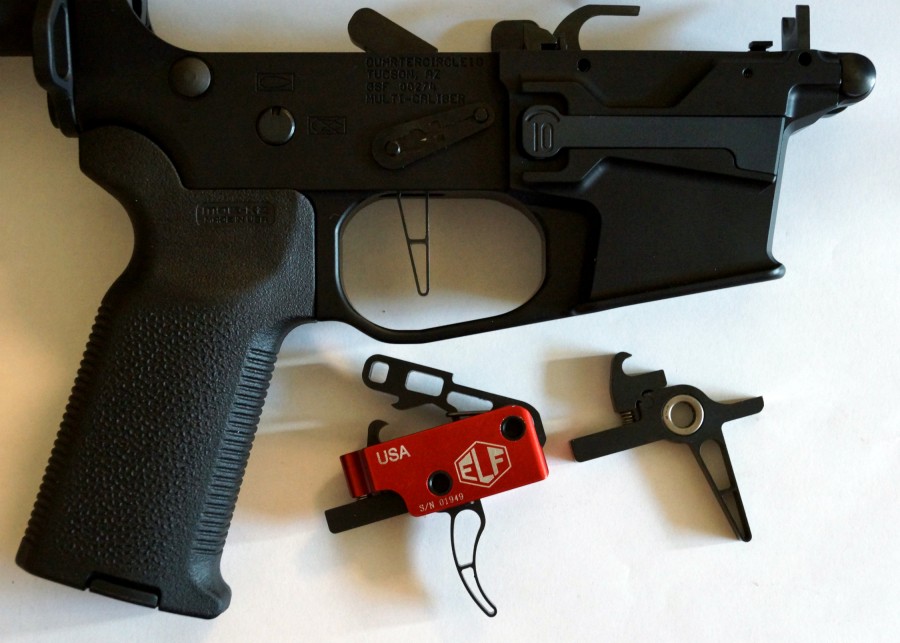
It isn’t really fair to consider this a knock against the ELF, which is designed for a normal AR-15, but it’s worth mentioning that it isn’t likely to work properly with a ramped, 9mm bolt. Two different 9mm AR uppers had the same problem — the ramped bolt didn’t push the hammer down far enough for the trigger to reliably reset. I’ve seen the exact same issue with parts kit hammers that are notched (red arrows in this photo point to the difference), and I expect lots of other triggers would have this problem as well.
Conclusion
T’aint cheap, but the ELF trigger is pretty solid. It looks good and it’s a star on the fundamentals. Adjustable pull weight and set screws to remove any play in the receiver are nice features. A full power hammer spring should ensure reliable function, and I’ve had no issues with it suppressed or unsuppressed.
RATINGS (out of five stars, compared to other drop-in AR triggers):
Fundamentals * * * * *
ELF claims it’s as good as a custom 1911 trigger. It actually is. For a semi-automatic firearm, this is a five star trigger.
Features * * * * *
Pull weight adjustment, receiver tension set screws, multiple trigger shoe and hammer options, needle bearings, half cock notch. More features than any of the competitive drop-in triggers.
Price * *
MSRP of $259 for the Match (and Service) trigger and $279 for the 3-Gun trigger is in the premium segment. The star rating here is not “value,” it’s just price. There are a couple that are more expensive (Tac-Con, Timney skeletonized), but most of the ones I’m checking out are less expensive and these ratings are going to be relative to the other drop-in models tested.
Overall * * * * *
It looks real good and it works real good. (please direct all grammar corrections to [email protected])

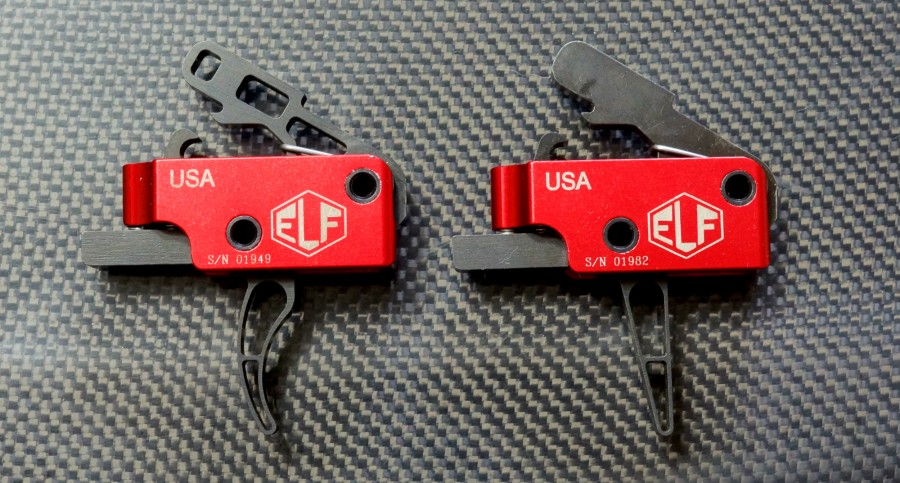

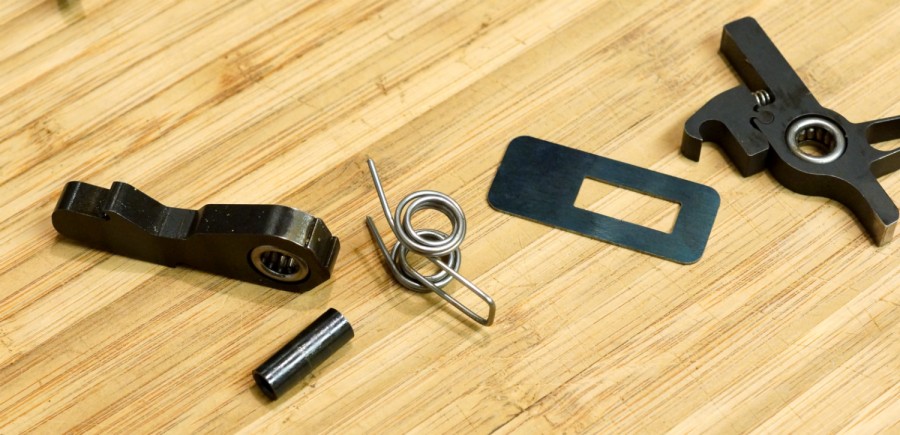

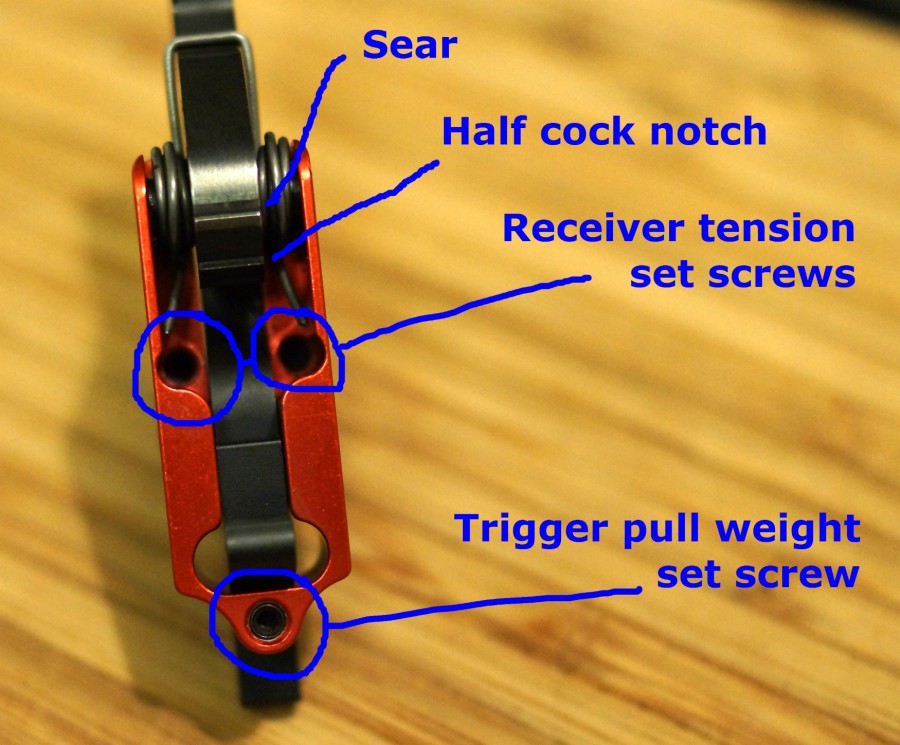
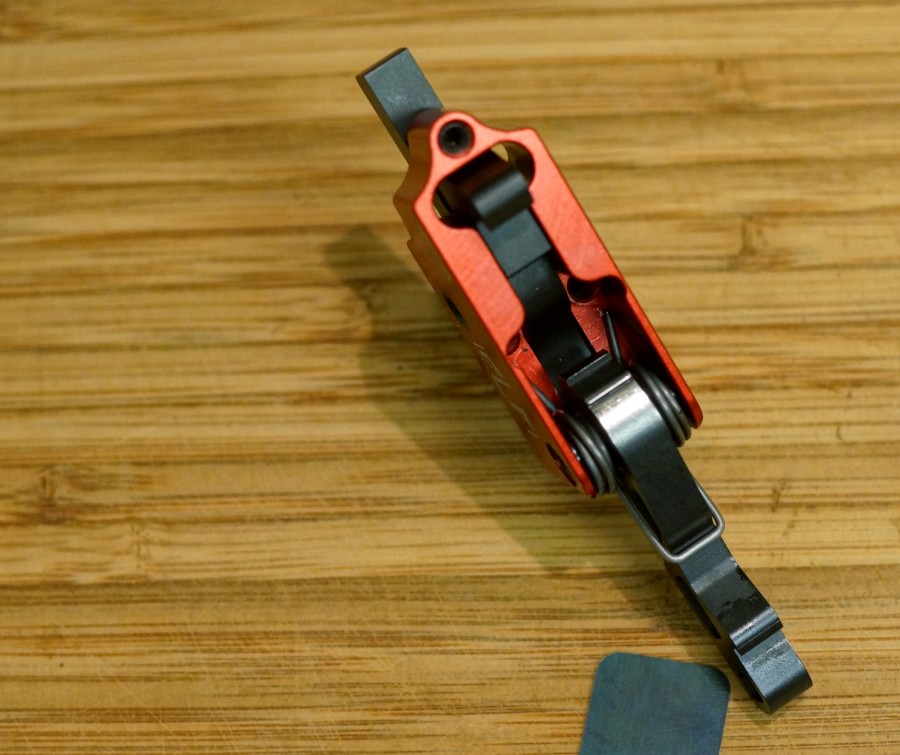
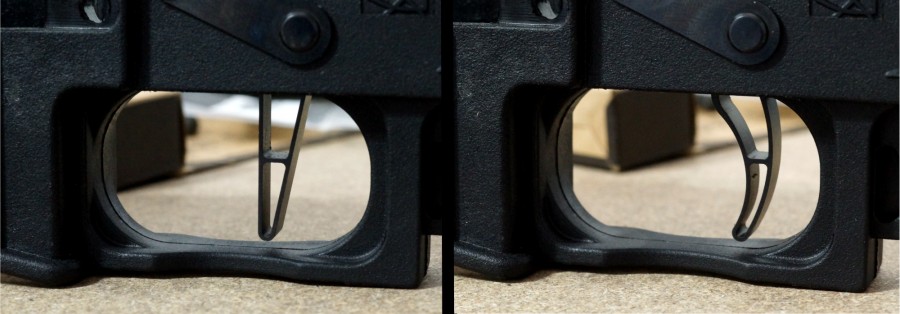
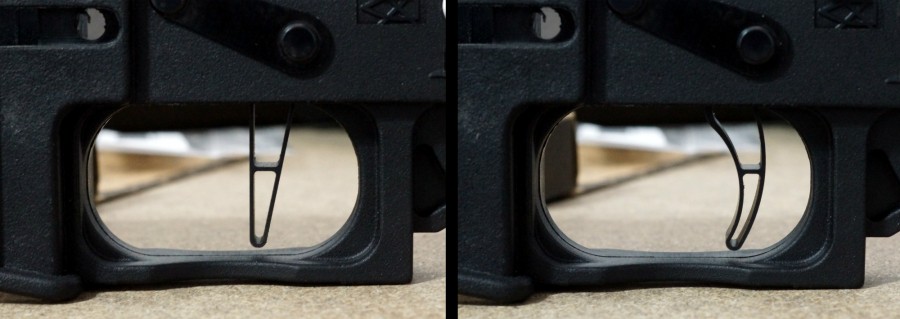
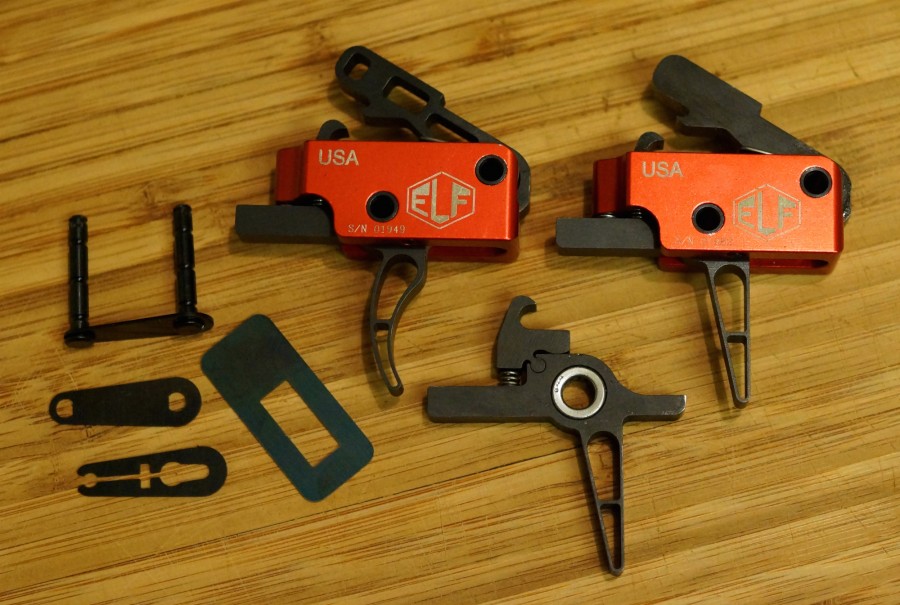



These are the best triggers on the market. Install is easy !!! worth the money
Great review.
Looks like a winner, guess I’m just gonna have to shell out the bucks, to find out for sure.
Nice review! I’d love to try one sometime. I have the Wilson Combat 1S, 3 gun, and NM trigger packs and for the record all three have a 1911-style “half-cock” notch. I am unsure of any other manufacturers, aside from now Elftmann that does this.
On a side note, even though the Wilson NM trigger is an outstanding two-stage match trigger, I can’t give it a solid recommendation as it has problems with hard primers such as CCI BR-4 and some mil-surplus loads.
Also I see your comment about compatibility with 9MM AR uppers… You are brave to even try a match trigger in such a violent action. I use ALG Defense triggers in mine, for a better-than-milspec pull without the risk of damaging an expensive aftermarket trigger pack.
With the full size disconnect and harder steel than a mil-spec trigger unit I’m not particularly concerned. My 9mm setup doesn’t bottom out the buffer weight in the tube or anything anyway (although I did switch to a standard carbine spring and weight, which did bottom out hard, just to make sure it wasn’t short stroking the system and not resetting the hammer for that reason). JP Enterprises Silent Captured Spring for 9mm, which uses a really heavy buffer weight, and the action is smooth and feels pretty gentle and definitely doesn’t bottom out. I don’t envision it being hard on triggers. But anyway this wasn’t the issue and the slightly higher height of the bottom of the bolt meant it didn’t push the hammer down far enough to reset it consistently. It was just on the edge of working, but not quite. Slightly better than my experience with the notched hammer, but on the 9mm bolt you really need that corner of the hammer to be nice and high and right where the mil-spec M16 hammer lives and it needs to reset in the same amount of travel (or less) as well.
At least with a ramped bolt. I think I shot it with a CMMG bolt and an Olympic Arms bolt. It’s possible there are other 9mm bolts out there that are “normal” on the underside and cock a hammer downwards just as far as an AR-15 bolt.
I too use a JP captured buffer in 9mm… as well as all my other ARs, unfortunately once you try one there is NO going back. Sort of like these aftermarket triggers, it’s just not the same. Anyways, I agree the action is nice and smooth with the JP buffer, especially coupled with the JP carrier, which is very heavy. As you experienced with the standard carbine buffer, that stroke is pretty hardcore. Even the factory RRA type “dedicated” 9mm buffers don’t do much to soften that impulse. I had never thought to see if the bolt ramp wasn’t allowing the trigger to reset properly, during my early pre-JP 9mm buffer testing I just figured it was the super fast bolt speed.
Looks like I have some tinkering to do when I get home.
Damn you! I have had zero interest in shelling out the cash for an aftermarket trigger – until now. I’m sure this will be well over $300 in my native land of Canuckistan, what with our tanking dollar and the mandatory price-gouging.
Aftermarket triggers are really nice And I’ve shit a couple. I just have problems shelling out the money for one when milspec is less than $50. If these triggers were around $150 then I would be all over it. As it is, I’ve shot some 1.5 and 1.6″ group’s at 100 yards with my current AR with milspec trigger using Wolf 55 grain .223. If i added a trigger it would add almost 50% more to the cost of my rifle. That’s also about 1000 rounds of ammo I could put through the rifle instead.
Amen, brother.
This is targeted for two types of folks:
1) The guy who thinks he can buy accuracy and skill in a plastic container in aisle 2 of the local Bass Pro Shop, and
2) The very rare skilled marksman (of which there are damned few) who can already shoot MOA groups with their set-up, but are looking to wring that last couple tenths of an MOA out everything.
Most folks would be a whole lot better off spending that cash on an Appleseed rifle course or similar offering from the U.S. Rifleman’s Association to learn how to shoot their rifles well, and the ammo for said marksmanship event.
You can’t buy skills in a bubble pack at a store.
John
Actually I think a third category may apply to more potential buyers. The gun is more enjoyable and fun to shoot, plus more fun to look at, with a decent trigger than it is with a mil-spec trigger. ’nuff said to justify the expense among many recreational shooters and hobbyists.
My AR isn’t my hunting gun and it isn’t my self defense gun. It’s just for fun. Whether plinking on the range and target shooting or maybe shooting 3-Gun stuff for fun (rather than for points and rank), it’s better with a better trigger. Not even for accuracy or skill. Just for enjoyment. The trigger feels better and it looks better. It is undeniably faster, if that matters. Basically anyone anywhere could shoot noticeably more rapidly with a nice trigger like this ELF than a mil-spec one thanks to the significantly shorter travel distance and lighter pull weight. May not matter in any scenario except for having fun making loud noises on the range (or 3-gun depending on skill level), but that’s a legitimate reason people buy firearms. And just like modifying cars, lots of us love modifying firearms — AR-15’s especially — to personalize them and make them unique. Plus the process of doing the actual tinkering is enjoyable. Aftermarket triggers are a huge part of that. Where’s the fun in shooting an AR with a parts kit grip, safety, mag release, stock, trigger guard, handguard, etc etc on it?
But I honestly do think that your average shooter would do markedly better shooting ground squirrels at 100+ yards with a trigger like this than with a mil-spec one. Your rare, skilled marksman can pull a gritty, heavy trigger without screwing up. A more average or recreational shooter is going to anticipate the recoil, won’t isolate the trigger finger as well, will move during the creep, etc, and I wouldn’t be surprised if that person saw a more pronounced benefit from an upgrade like this. It can be a “bandaid” that makes flawless trigger pull fundamentals less important because the trigger pull itself is so very much shorter.
One can also shoot faster, and with less trigger finger fatigue, with a lighter trigger that has less travel and wasted motion. That’s probably not much of a factor in a 30 round mag dump, but it becomes more of a factor blowing through a 100 round mag.
While chrome-lined barrels often max out at 1.5 – 2.5 MOA accuracy-wise, stainless steel AR barrels can consistently beat 1 MOA. A decent trigger definately helps in that equation.
I’m a 3rd category. I like nice things.
I don’t “need” alloy rims or power windows on my truck, I didn’t “need” a bigger TV and I don’t “need” this trigger in my AR.
I do work hard for my money though so why shouldn’t I have some “wants” with my “needs”? It won’t give me magical keyhole groups at 1000 yds….. To be honest it probably won’t do a damn thing for my accuracy but I will know it’s there whenever I shoot the rifle. That’s enough for me.
i can shoot tight groups, how ever i absolutely agree with you to have the best is a reward in its self…pride of ownership is nothing you have to apologize for.
@sixpack:
LOL at your first sentence. You mean you’ve “shot a couple,” right? 😉
Well the good news is that not all of these aftermarket triggers are that expensive. Not even all of the drop-in ones. For instance, the Velocity Trigger that I have here to test out has an MSRP of $150, and I saw it about a month ago on sale at an online retailer for $99. I have yet to take it shooting but in the dry fire rig I have it’s certainly a very nice trigger on the fundamentals. You can get into even lower prices if you go with normal, 2-piece (separate hammer and trigger not assembled in a drop-in unit) aftermarket triggers like ALG and such.
My ALG QMS rang in at $45 including shipping. It is a very clean single stage trigger with a crisp break and no creep and minimal overtravel. The only downside is that it is a bit on the heavy side. I haven’t measured it, but I think it is around 7 or 8 lbs. And of course, it is much easier to install one of these fancy drop-ins than it is to fight the springs to get everything in a two-piece trigger assembly in the right place. (Since I was working with a homebuilt lower, I had the pleasure of installing, removing and reinstalling the trigger several times before I got the milling and filing where it needed to be.)
For 150.00 get a Velocity trigger. Actually I think I paid 135.00 on Amazon. Amazing triggers and I believe the review I read was from this same author after he had tested the majority of the triggers for this series of tests and he said this elftman and Velocity were almost identical.
The AR Gold trigger has a drop safety like you are describing here. It will catch if the sear slips.
Yes, but it’s done via a different method instead of with a half cock notch. I’m hoping I can get my hands on an AR Gold for this “shootout” as well. I think it and a Black Rain Ordnance are really the only drop-in ones still up in the air for inclusion in the testing. And Tac-Con, although it’s sort of in its own segment.
Perhaps it is just me but some of those triggers look awfully “dainty.” I’d be afraid of breaking them, they look so thin and fragile.
The look of the skeletonized trigger is one reason I like these things so much. I think it’s dang cool. I have no idea how much weight is necessary to bend or snap the trigger ‘blade’ but I do know it’s more than I’m capable of applying with just my trigger finger. Pulling as hard as I physically can, it doesn’t so much as flex. At least the straight one doesn’t — I didn’t attempt to break the curved one.
Thanks for defining the trigger terms – that’s the first time I’ve seen them defined.
I was a little worried it would make this too long, but it’s sort of like a “primer” for the rest of the drop-in trigger pack reviews and then the “shootout” at the end. They’ll all be compared on the same fundamentals and it’s important to know what those are — or at least how I define them. If there’s any one aspect that may need clarification, I do often see take-up and creep confounded instead of treating them as two, entirely separate things (which they are). In many cases, a trigger with a lot of take-up/slack in it can still have almost no creep, and if you “ride the reset” on subsequent shots you never experience that take-up again… so the distinction has real-life relevance.
I recently installed one on my 300BLK SBR. I like it so much I’m going to buy 4 more. Pricey but worth it.
Have one in my rifle and absolutely love it. It is a outstanding trigger and the customer service is top notch
Jeremy: just a quick note to let you know your reviews are excellent. Thanks for the hard work. I always look forward to your articles.
I haven’t visited this review in a long time, so missed these comments. Thanks for the kind words, Eric! Very nice, but clearly you have poor taste 😛
Thanks! This was a great review as well as a darn good primer on triggers and terms.Well written, to the point and not boring or repetitive with very clear descriptions.
I’m in the 4th camp on all these add-ons: I want my gear the way I want it. It’s not a matter of need; it’s deserve. That’s as in: I deserve to have a grand time on my time spent in recreation and research to do the best I can. This is to eliminate as much gear performance issues and create as much advantage as possible so all that’s left is my head and my training.
There are enough gremlins in competition that making guns & ammo run 100% for 10 stages is at least 1/2 the equation. Plus, it amps the fun factor to have stories around the camp in the evening!
Thanks for the reviews…..I teach long range marksmanship and shoot for pleasure now rather than professionally in the Marine Corps for 32 years….This trigger assembly intrigues me enough to buy one and try it with it’s adjustable pull weight and roller bearings making for a smooth pull….
If you got one or end up getting one, let us know how it works for you!
I agree with Tim Reynolds, trigger pull is a fundamental of accuracy. The smooth reliable consistent pull, reset etc. will improve any shooter. All the 5 star comments are valid in the context of trigger fundamentals. Many AR,s currently will hold 1 MOA or better out too the range the ammo will support, and the shooters ability to consistently execute the fundamentals, and read winds. Sealed roller bearings sounds does move me towards the thought of reliability for what we are looking for here. Also the pull WT of about 3 may be what works for me, if not maybe 4lbs. Better than 7 or 8. I hope its durable to last the long haul of field duty.
Had two of these. Was really excited about them too. Installed one in an LWRC Six8 16″, one in a 10.5″ LWRC 5.56. Ran great, loved the feel, the adaptability and everything about them. Then I installed my silencers. The trigger in the 6.8 was the 3-gun and immediately ceased functioning. Every shot, you could open the rifle from the takedown pin and the hammer was invariably set at the “drop safety” position (Half-cocked so to speak). I would have a light strike, a faint click, and a manual cycle. Upon seeing this, I tried it in my 5.56. It worked fine for 40 rounds of PMC Bronze, then it started double tapping. Then opened up on full-auto. The trigger would maintain a constant stream of fire as long as the trigger was held. Thinking perhaps it didn’t work well with the LWRC piston set up, I put both triggers into a Noveske Gen3 5.56. The same issues persisted. Geissele, Hiperfire (Which is now my personal preference), and mil spec triggers never have this problem in any of my rifles. I’d advise anyone who owns a silencer to very carefully consider purchasing these triggers. As far as any AR we’ve run these triggers in unsupressed, we’ve had zero trigger related issues. But we have a large NFA presence in our area, and these triggers do not work for that.
That’s weird! They’ve worked fine for me with (and without) suppressor in 5.56 and .300 BLK in a handful of uppers and three lowers. In both of your cases of improper function they may simply need a little tuning on the pull weight set screw or double checking that the receiver tensioning screws are snug. On many of these drop-in units that have those tensioning screws, they are apt to double on you if the screws aren’t tight and the pull weight is set fairly low. It seems to introduce enough free play that the sear misses the hammer hook, and it’s exacerbated by a low trigger weight adjustment since it means the return spring isn’t pushing the sear up against the hammer with as much force (meaning it’s slower than it should be). If yours is going full-auto it’s missing the primary hammer hook and the half cock notch, and my guess is that it would stop this entirely if you tighten the pull weight adjustment (and ensure that the receiver tensioning set screws are snug, which should always be the case to remove wiggle in the trigger anyway)…
Definitely a downside to units that are end-user-adjustable. I’ve seen similar feedback (mostly RE doubling or a hammer that just follows the bolt home) on a lot of brands that offer adjustment. And, yes, sometimes they even ship from the factory adjusted too light. But usually it’s forgetting to snug up those two set screws that take up the slack inside of the receiver and pin the unit against the trigger pings…
I understand exactly what you’re saying sir. If I may explain, I managed a firearm store for 5 years, installing countless triggers (Geissele, Hiperfire, CMC, Mil Spec, Elftmann, Timney, and more) in that tenure before starting a small AR manufacturer. Upon noticing the problem with the Six8, the first solution was to check every screw and make sure it was tight. Seeing they were, I then utilized blue Loctite and a week’s wait. I skipped Loctite at first for my personal rifle, because I’ve found most often it isn’t necessary. Utilizing the trusty torque wrench, the screws for the Six8 were set to 30PSI (I believe I later set the 5.56 triggers to 20PSI to accommodate the lighter caliber).The issue persisted. Then, came the inevitable playing with the weight. I loved it at about 3.25#, but was ready to sacrifice that for proper function. However, it still had the same effect. Repeat for the “Match” version in the 5.56 rifles. I sold my two triggers to individuals who have no interest in NFA items and very clearly explained why I was selling them. I routinely diagnosed 3 rifle problems a day (it was also an indoor range) on the AR platform. Also of note, the Noveske and Six8 were geared for hunting. The trigger weights were definitely not set to match weights.
Additionally, I lost all interest in working with the manufacturer. Working through their marketing group, I was informed multiple times about how they were a company with problems and unsure of their place, their product, and the market in general. The crown jewel for working with them, was a customer calling the company and getting put on the line with president of the company. The president then told my customer he would sell the individual anything they made at his cost (which was, naturally, well below my dealer price). Upon asking about this to Elftmann, through 2 phone calls, 2 emails, and a very serious call to their marketing group, I was left with silence, or that they were not going to act on it and did not seem bothered in the least that they had undercut a dealer.
Great review if this trigger were put on a bench rest rifle, but the AR isn’t designed for that. My concern is with the needle bearings. The bearings themselves don’t look to me to be sealed. I know the trigger has its own housing which offer some protection, but that begs the question, how will these perform in a dirty, dusty, sandy, and muddy environments? Not sure how they’d perform as smooth in real world or a combat situation.
It would be nice if future reviews included real would environment tests, not sterile “indoor and perfect range days”. But good to know it was tested in a 9mm, that always helps. Come on!
I think you really need to do a heads-up comparison with the AR Gold and the ELF trigger. I believe the lock time and reset are better on the AR Gold, and it is a 2-stage vs. a single stage. They go down to 1.8lbs vs 2.5 and is adjustable as well. It has a drop safety that will catch if somehow the trigger isn’t depressed but the rifle is dropped or smacked hard. It is as crisp as I’ve felt any trigger and compared it to a Geissele NM, Timney, Velocity, and JP. I think that would be an amazing side by side.
I bought an aElftmann 3gun trigger from a dealer around here and had intermittent reset issues that led to constant issues.
Fortunately I live real close to their headquarters (which is currently quite small.) I callled over there and the owner answered. I told him my issues so he told me to meet him at his office the next morning. Very cool guy. He showed me around where they made these triggers and explained that the two or three machines they currently had was soon going to need to be added to at least two fold. They’re getting real big and doing well. Anyway Art the owner replaced my trigger at no charge and is a great guy. Great biz too.
Both of mine are broken. The one I don’t shoot as much has started to have intermittent failures to reset, the one I shoot a lot has completely failed to reset. Junked them both. Not interested in a replacement. Fantastically disappointed.
What 9mm bolt carrier group did you use? I have this trigger in my cmmg 9mm ar-15 it works but it sometime does not cock the hammer. I’m going to get the jp enterprises 9mm bolt carrier group and see if it makes a difference between the two I’ll keep you updated if it helps with the problem.
You’re a very useful internet site; couldn’t make it without ya!
Holy necro posting. Great trigger. I bought the 3-gun straight trigger this summer (July 2018). The product has changed a little. I emailed Elftmann with these questions:
I bought and installed an Elf 3-gun trigger earlier this summer and love it. Two questions:
1) Reviews said there are two screws that screw down against the set screws. Mine didn’t come with them but the set screws themselves had some type of coating on them that made them very hard to screw in and out. Is this a design change or do I need the two screws that didn’t come with my trigger?
2) Do I need to lubricate the bearings or any other parts of the trigger assembly?
I got these answers back:
Thank you for your inquiry. It sounds as though you have our new set screws. They are longer and nylon coated eliminating the need for the second set of locking screws. You do not need to lubricate the trigger. If you want to clean it you can use any CPL.
Comments are closed.